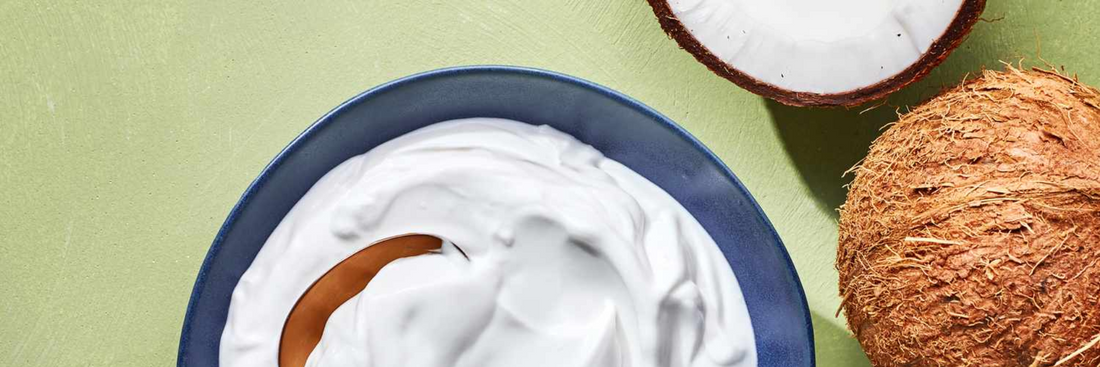Coconut cream and coconut milk are popular ingredients in many cuisines, particularly in tropical regions. They are derived from the flesh of mature coconuts and have distinct characteristics, uses, and nutritional benefits. This article aims to clarify the differences between coconut cream and coconut milk, provide information on their uses, nutritional benefits, and offer a guide on how to make coconut cream at home.
- Types Of Vanilla Products. Which Type Of Vanilla Product You Should Use?
- 15 Best Butter Substitutes Baking That You Should Know
- Exploring the Most Expensive Cheese List In The World
What is Coconut Milk? Understanding the Basics

Definition: Coconut milk is a milky liquid extracted from the grated flesh of mature coconuts.
Process: To produce coconut milk, the grated coconut flesh is mixed with hot water. This mixture is then strained, resulting in a smooth, creamy liquid. The remaining solid can be used for other purposes, such as in desserts or as animal feed.
Common Uses: Coconut milk is versatile and can be utilized in a variety of dishes, including soups, curries, stews, beverages, and desserts. Its creamy texture and subtly sweet flavor make it a key ingredient in both savory and sweet recipes.
Variations: Coconut milk comes in different fat percentages, such as full-fat and light versions. Full-fat coconut milk contains around 17-24% fat, while light coconut milk has a lower fat content, typically around 5-7%. This allows for flexibility based on dietary preferences and recipe requirements.
Cultural Significance: Coconut milk has great importance in various cultures, particularly in Southeast Asian, Caribbean, and South American cuisines. Dishes like Thai green curry and Caribbean rice and peas showcase its integral role in vibrant, traditional meals.
Versatility: The ability to blend seamlessly into both savory and sweet dishes makes coconut milk a staple for many chefs and home cooks alike. From creamy soups to indulgent desserts, it adapts well to diverse cooking styles.
Dairy-Free Alternative: As a popular substitute for dairy milk and cream, coconut milk is often favored by those with lactose intolerance, as well as vegans and people following plant-based diets. This versatility opens up opportunities for everyone to enjoy creamy textures without dairy.
What is Coconut Cream? Exploring its Richness
Definition: Coconut cream is the thicker and richer layer that rises to the top of a can of full-fat coconut milk. It can also be produced by using a higher ratio of coconut flesh to water in the extraction process.
Process: Similar to coconut milk, the extraction process for coconut cream involves grating coconut flesh; however, it contains less water or is created by refrigerating full-fat coconut milk and skimming the top. This results in a denser, creamier product.
Common Uses: Coconut cream is ideal for whipped toppings, rich sauces, desserts, and as a thickening agent in various recipes. Its luxurious texture lends itself well to treats such as coconut cream pies or fluffy frostings.
DIY Option: Coconut cream can be easily made at home. By refrigerating a can of full-fat coconut milk overnight, you can scoop out the creamy top layer, turning it into homemade coconut cream — a simple and cost-effective alternative to store-bought varieties.
Tropical Indulgence: Often associated with decadent and creamy desserts, coconut cream enhances dishes with an exotic flair, making it a popular choice for celebratory and special occasion recipes.
High Fat Content: With a significantly higher fat content compared to coconut milk, coconut cream provides a richer texture and flavor profile. This increased creaminess is particularly sought after in desserts and sauces.
Whipping Capability: When chilled, coconut cream can be whipped into a dairy-free alternative to whipped cream. This makes it an excellent option for topping cakes, fruit bowls, and other desserts, providing a delightful experience without dairy.
By understanding the differences between coconut milk and coconut cream—alongside their respective uses—you can elevate your cooking and baking with these delightful ingredients. Whether you're looking for a creamy addition to savory dishes or a luscious element for desserts, both offer unique benefits worth exploring.

Key Differences: Coconut Milk vs. Coconut Cream - A Detailed Comparison
Fat Content: The Primary Distinguishing Factor
Coconut milk and coconut cream are both derived from the flesh of coconuts, but their fat content is what primarily sets them apart.
- Coconut Milk: Typically contains about 5-7% fat. This lower fat percentage gives it a lighter texture, making it ideal for dishes where a creamy but not overly rich flavor is desired.
- Coconut Cream: Contains around 20-30% fat, resulting in a much thicker and richer consistency. This higher fat content contributes to its luxuriously creamy texture, making it perfect for indulgent desserts and rich sauces.
The significant difference in fat content not only affects the texture but also the overall richness of the dishes in which they are used. Coconut cream provides a more decadent flavor experience, while coconut milk offers a lighter, refreshing note.
Texture and Consistency
When it comes to texture, coconut milk and coconut cream are distinctly different.
- Coconut Milk: It is thin and liquid, resembling dairy milk. This characteristic makes it suitable for incorporating into various recipes that require a lighter consistency.
- Coconut Cream: In contrast, coconut cream is thick, almost like soft butter. Its creamy consistency is perfect for adding richness to recipes or using as a topping.
The two ingredients are often used in varying proportions to achieve the desired texture in a dish, be it creamy or light.
Production Process
The method of production also highlights the differences between coconut milk and coconut cream.
- Coconut Milk: Produced by blending fresh coconut meat with water and straining the mixture to extract the liquid. The ratio of water to coconut meat is relatively high, resulting in a thinner liquid.
- Coconut Cream: Made in a similar manner but with a lower water content. After the coconut milk is extracted, it can be refrigerated to allow the cream to rise to the top. This solid portion is then skimmed off to obtain coconut cream.
This distinct production process ensures that each ingredient has its unique properties, tailored for various culinary uses.
Culinary Applications
Understanding when to use coconut milk versus coconut cream is key to achieving culinary success.
- Coconut Milk: Ideal for lighter curries, soups, smoothies, and beverages like Thai iced tea. It can also be used in lighter desserts, such as puddings and custards, where a subtle coconut flavor is desired without overwhelming richness.
- Coconut Cream: Best suited for rich sauces, gravies, and as a whipped topping for desserts. It also serves as an effective thickening agent in dishes where creaminess is essential, offering a luxurious finish.
The choice between these two ingredients can greatly influence the outcome of dishes, enhancing flavors and textures accordingly.
Nutritional Profile
When comparing the nutritional profiles of these two coconut products, notable differences arise.
- Coconut Milk: Generally lower in calories and fat, making it a suitable choice for those watching their fat intake. It also contains smaller amounts of carbohydrates.
- Coconut Cream: With its higher fat content, it also boasts a greater calorie count but is rich in vitamins C and E, as well as minerals like iron and potassium.
Both contain beneficial nutrients, but the specific amounts and types differ, influencing their healthy appeal based on dietary needs.
When to Use Coconut Milk vs. Coconut Cream: Practical Guidance

Recipes Calling for Coconut Milk
Coconut milk shines in various recipes, particularly those that require a lighter touch.
- Light Curries and Soups: Use coconut milk to create a velvety base that complements vegetables and proteins without overwhelming them.
- Beverages: Perfect for blending smoothies or crafting a refreshing Thai iced tea, where a light, milky consistency is desired.
- Lighter Desserts: Ideal for puddings and custards, coconut milk adds subtle coconut flavor without being overly rich.
Recipes Calling for Coconut Cream
Coconut cream is the star ingredient in dishes that require depth and indulgence.
- Rich Sauces and Gravies: Its thick, creamy texture elevates combined ingredients, resulting in a luxurious sauce perfect for drenching over meats or vegetables.
- Whipped Toppings for Desserts: Coconut cream can be whipped into a fluffy topping, perfect for cakes and pies, adding a delightful finish.
- Thickening Agent: Works wonderfully in recipes requiring a creamy consistency—for example, in certain pasta dishes or creamy soups.
Can You Substitute One for the Other?
Substituting coconut milk for coconut cream, or vice versa, can sometimes be done, but with considerations.
- If you need to use coconut milk instead of coconut cream in a recipe, you may end up with a lighter texture and less richness. However, you can compensate by adding a bit of flour or cornstarch to thicken the dish.
- Conversely, substituting coconut cream for coconut milk in a recipe will likely yield a richer flavor, but it may alter the overall dish's texture and heaviness.
Understanding these nuances can help you achieve the desired outcome in your culinary creations.

Conclusion
Coconut milk and coconut cream serve unique purposes in the kitchen, fundamentally different in terms of fat content, texture, and culinary applications. These differences equip you with the knowledge to confidently use both ingredients in your cooking and baking adventures.
As a final tip, always check the labels on packaged coconut products, as some brands vary in thickness and fat content. Experimenting with these coconut staples will invariably enhance the flavors and textures of your dishes, bringing a taste of tropical delight into your kitchen.
Frequently Asked Questions (FAQs)
What is the difference between cream of coconut and coconut cream?
Cream of coconut is a sweeter, thicker version that is often used in cocktails and desserts, while coconut cream is unsweetened and used for savory and sweet dishes.
Can I make coconut cream from coconut milk at home?
Yes, by refrigerating full-fat coconut milk, the cream will rise to the top. Skim it off after it has cooled to create your homemade coconut cream.
Is coconut milk or coconut cream healthier?
Coconut milk is lower in calories and fat, making it a better option for low-fat diets, while coconut cream is denser in nutrients, but higher in calories and fat.







